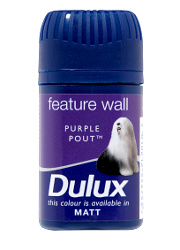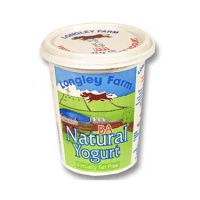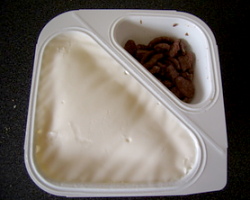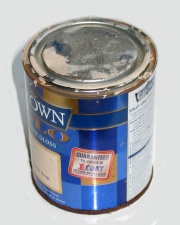How can I reuse or recycle little paint tester pots?
 We covered old leftover paint on the site many, many moons ago (roughly 66-67 moons ago apparently) but these last few weeks, we’ve been rather overrun with little tester pots of paint here.
We covered old leftover paint on the site many, many moons ago (roughly 66-67 moons ago apparently) but these last few weeks, we’ve been rather overrun with little tester pots of paint here.
I hate tester pots from an environmental point of view – usually plastic pots, sometimes with an integral brush, that are thrown away once their purpose has been served – but I’ve made enough costly paint mistakes in the past (and in the very recent past, she says knowing there is £80 worth of unsuitable-for-current-job paint sat upstairs…) to begrudgingly accept using them.
I think there are two questions here: how can I use up the little bits of paint? And second, is there anything I can do with the little pots?
The amount of paint in each tester is only enough for very small projects. I remember at uni painting a set of drawers with leftover tester pot paint – each drawer a different shade of blue – and the sides of the pots themselves tell me they’re suitable for stencilling, where you just need a little paint of each colour. Have you done (or seen) any mini-craft projects using leftover tester pot emulsion paint?
As for the pots themselves, the ones I have here tell me they’re polypropylene – plastic number 5 – which can be recycled but isn’t collected everywhere yet. The pots seal very tightly – as you’d expect from something containing paint – and so they could be washed out & reused for containing other liquid things or keeping other things dry or safe. I won’t use them for anything food related – since they’ve contained paint and aren’t food grade – and probably not anything like plant seeds either — but they’d be fine for small amounts of non-edibles/growables: like old film canisters, they’d be useful for all sorts of little fishing related things, for beads or buttons, and nuts/bolts/screws or sewing needles etc.
What would you reuse them for?
























How about this? http://blog.craftzine.com/archive/2012/03/how-to_wooden_floor_mat.html It looks fab and would be great for using up scrap bits of wood too :)
Funnily enough, I starred that on Google Reader the other day and it’s on my to-make list over the next few weeks! I saw this one to start with – http://pinterest.com/pin/168885054745870959/ – but I’ll find it easier to find lots of short pieces of scrap wood than long ones. I might use the string-through-it idea from the second one though, rather than the metal bars from the first one for cheapness sake :)
I actually like those mini containers of paint as they work perfect for small projects. Like paint a chair, or a table, or a shelf, each in a different color or shade, and as often as you like since those small containers are usually very affordable.
I don’t think I’ve done anything too creative with the containers, other than rinse them and use them for storing some paint for emergency purposes. Like the paint you used for the walls for any emergency fixes later. There will be much less air in those containers so the paint should stay a bit longer too. And you don’t have to search for a brush. Just mark the correct paint type and shade and where it’s used before storing it.
I’ve seen some neat fabric art using tester pot paint to transfer a photocopy image onto cotton fabric. I couldn’t find a tutorial on the web (though I’m sure there must be one). Basically, paint a bit of fabric, put the photocopy image side down onto the paint, brayer/press it down and let it dry. When the paint is dry, wet the paper and rub it off, leaving the image (in reverse) in the paint. The image isn’t crisp, sort of what you would expect an old fresco to look like. The technique is supposed to work with other types of image, so long as the ink is water resistant, but I only saw it with photocopies.
House paint can also be used to stencil onto fabric, and that doesn’t need much paint either.
I’ve not tried either of these techniques, so I couldn’t tell you how well they last.
Add some tile grout and make blackboard paint. Darker colours work best. The paint in a sample pot should cover around an A3 space. You’ll need more if you’re doing something bigger like a whole wall. See here:
http://www.zimbio.com/Blackboard+Paint
The little sample paint pots are ideal for putting lipsticks in to organise your make up box/try they hold about four depending of the size of tube. Film make good storage for salt pepper when travelling or camping. If I do a paint on the wall project the little bit of paint left inside is ideal for this. The left over paint is also useful to paint little earthward plant pots.
If anyone has old tester pots I certainly could re-use them. I work for a company that has a lot of fork lift trucks and we buy in specific paint to touch them up. The trucks get quite a lot of wee scrapes and having paint in a tester pot would be ideal for the operators to touch up any small scrap without having to worry about cleaning brushes or rollers etc. if anyone has a number of old tester pots I would be very interested in taking them ( providing the brush is still soft )
Depending on the size and shape, paint tester pots are useful containers for geocachers to use to set up their own caches. If you have a lot, you could advertise them on ebay for this purpose. You could cover them with camo tape and sell them for more!